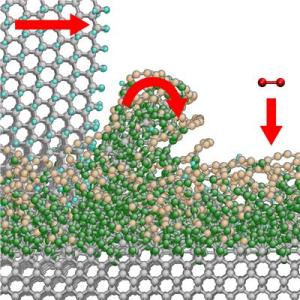Nov 30 2010
It is the hardest material in the world, and yet it can not only be used to cut other materials, but can be machined itself.
Already over 600 years ago first diamonds were cut and the same technique is still used to transform precious stones into exquisite jewelry and later into unrivaled industrial tools. Dr. Lars Pastewka’s and Prof. Michael Moseler’s team at the Fraunhofer Institute for Mechanics of Materials IWM in Freiburg/Germany can now reveal the secret of why it is that diamonds can be machined. The team published its findings in the current online issue of Nature Materials. This work represents major progress in tribology -the research of friction and wear. Despite the great significance for industry the scientific basics of tribology are poorly understood.
 Material removal mechanism during diamond polishing
Material removal mechanism during diamond polishing
Diamonds have been ground by craftsmen for hundreds of years using cast iron wheels studded with fine diamond particles turning at around 30 meters per second at the outer rim. A highly tuned sense of sound and feeling enable an experienced diamond grinder to hold the rough diamond at just the right angle to achieve a smooth and polished surface. The fact that diamonds react directionally has been known for a long time, says Lars Pastewka. The physical phenomenon is known as anisotropy. The carbon atoms in the diamond lattice form lattice planes, some of which are easier to polish than others, depending on the angle at which the diamond is held.
For hundreds of years, researchers have been looking for a logical way of explaining this empirical phenomenon, and have so far been unsuccessful. Equally, no one has been able to explain why it is possible that the hardest material in the world can be machined. The scientists in Freiburg have answered both these questions with the help of a newly developed calculation method.
Michael Moseler explains the method in layman’s terms: »The moment a diamond is ground, it is no longer a diamond.« Due to the high-speed friction between the rough diamond and the diamond particles in the cast iron wheel, a completely different »glass-like carbon phase« is created on the surface of the precious stone in a mechanochemical process. The speed at which this material phase appears depends on the crystal orientation of the rough diamond. »This is where anisotropy comes in«, explains Moseler.
The new material on the surface of the diamond, adds Moseler, is then »peeled off« in two ways: the ploughing effect of the sharp-edged diamond particles in the wheel repeatedly scratches off tiny carbon dust particles from the surface - this would not be possible in the original diamond state, which is too hard and in which the bond forces would be too great. The second, equally important impingement on the normally impenetrably hard crystal surface is due to oxygen (O) in the air. The O2 molecules bond with carbon atoms (C) within the instable, long carbon chains that have formed on the surface of the glassy phase to produce the atmospheric gas CO2, carbon dioxide.
And how was it possible to determine when and which atoms would detach from the crystalline surface? »We looked extremely closely at the quantum mechanics of the bonds between the atoms at the surface of the rough diamond breaking. We had to analyze the force field between the atoms in detail«, explains Lars Pastewka.
If one understands these forces well enough, one can precisely describe - and model - how to make and break bonds. »This provided the basis for investigations into the dynamics of the atoms at the friction surface between a diamond particle on the wheel and the rough diamond itself«, adds Pastewka. He and his colleague Moseler have calculated the paths of around 10,000 diamond atoms and followed them on screen. Their calculations paid off: their model is able to explain all the processes involved in the dusty and long misunderstood method of diamond grinding.
The newly developed model is not only a milestone in the field of diamond research: »It proves also that friction and wear processes can be described precisely with modern material simulation methods ranging from the atomic level to macroscopic objects.« emphasizes Prof. Peter Gumbsch, director of the institute. He considers this just as one example of the many questions on wear that industry needs answers to. These questions will be addressed in future by the Fraunhofer IWM within the newly founded MicroTribology Centre µTC under the motto »make tribology predictable«.